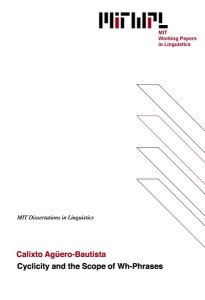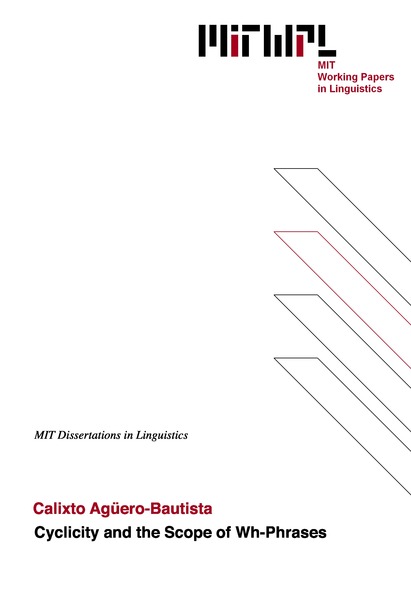Cyclicity and the Scope of Wh-Phrases
C. Agüero-Bautista, 2001
This dissertation argues that in the context of constituent questions with quantifiers, there is a particular interpretation (i.e. the PL interpretation) that, when understood properly, tells us if and how the wh-phrase has moved. In particular, the thesis argues that in a constituent question with a universal quantifier, syntactic reconstruction of the wh-phrase below the quantifier is the source of scope ambiguities. I argue, based on the interaction of PL readings with binding conditions A and C, that syntactic reconstruction of the wh-phrase below the quantifier is necessary for the PL readings or family-of-questions interpretation to be available.
The thesis takes as a starting point the assumption, fundamental to the approaches of May (1985), Aoun and Li (1993), and Chierchia (1993), that wh–quantifier interaction is subject to a nesting–crossing asymmetry. Two things are shown in the first two chapters: 1) that the subject–object asymmetry is a relative phenomenon depending on the type of the quantifier used (whether one uses each vs. every) and the type of the wh-phrase extracted (e.g. a which-phrase vs. a how many–phrase), and 2) questions with quantifiers exemplifying nesting configurations are in fact unambiguous when reconstruction of the wh-phrase is blocked by binding theoretic principles. The data show that nesting is insufficient, whereas reconstruction is a necessary condition for the availability of PL readings. The proper treatment of wh–quantifier interaction is therefore one that treats the phenomenon in terms of reconstruction.
The second part of the thesis argues that reconstruction is necessary for PL readings, because such interpretations are a particular case of variable binding in which the universal quantifier binds an implicit variable in one of the copies of the wh-phrase, which is analyzed as a skolemized choice function as in Kratzer’s (1998) theory of indefinites. It is argued on the basis of empirical considerations that WCO is irrelevant contra Chierchia (1993) because WCO does not apply in the case of implicit variables.
The third part of the dissertation shows that the reconstruction view of PL readings opens up the possibility of using such interpretations as a diagnostic for successive cyclicity (i.e. to tell us if and how the wh-phrase has moved). It is argued that using the distribution of PL readings as a diagnostic for cyclicity can shed some light on the phenomenon of clitic doubling in Spanish. In addition, by comparing the interaction of overtly displaced wh-phrases with quantifiers, on the one hand, and the interaction of wh in situ and universal quantifiers, on the other, I have argued that whereas overtly moved wh-phrases move in successive cyclic fashion, wh-phrases in situ do not get their scope via successive cyclicity. The analysis is also relevant to the syntax of sluicing.
Thesis Supervisor: Irene Heim, Professor of Linguistics
| 1 | The proper treatment of scope ambiguity in questions with quantifiers | 8 | |||
| 1.0 | Introduction | 8 | |||
| 1.1 | The proper treatment of wh–quantifier interaction | 15 | |||
| 1.1.1 | May’s view | 16 | |||
| 1.1.2 | Aoun and Li’s approach | 21 | |||
| 1.1.3 | Evaluating scope-principles-based approaches | 24 | |||
| 1.1.4 | The Weak Cross Over (WCO) account of wh–quantifier interaction | 26 | |||
| 1.1.4.1 | An unattested prediction of the WCO account | 28 | |||
| 1.1.5 | Summary | 29 | |||
| 1.2 | Problems with the subject–object asymmetry | 30 | |||
| 1.2.1 | Problems with the quantifier each | 30 | |||
| 1.2.2 | Problems with the quantifier every | 32 | |||
| 1.2.3 | The plurality hypothesis | 33 | |||
| 1.2.4 | Problems with the plurality account | 36 | |||
| 1.2.4.1 | The double plural requirement (DPR) | 36 | |||
| 1.2.4.1.1 | Spanish who-phrases and PL interpretations | 37 | |||
| 1.2.4.1.2 | Questions with quantifiers of the form every–NP and the DPR | 41 | |||
| 1.2.4.2 | Cumulative readings vs. PL interpretations in weak islands contexts | 43 | |||
| 1.2.4.3 | Cumulative readings, PL interpretations, and exhaustiveness | 46 | |||
| 1.2.5 | Interim summary | 50 | |||
| 1.2.6 | The subject–object asymmetry as a relative phenomenon | 52 | |||
| 1.2.6.1 | A preliminary proposal | 56 | |||
| 1.2.7 | Summary and conclusion | 57 | |||
| 2 | A reconstruction view of scope ambiguity in questions with quantifiers | 59 | |||
| 2.0 | Introduction | 59 | |||
| 2.1 | Syntax | 60 | |||
| 2.1.1 | BT(A) reconstruction and PL interpretations | 62 | |||
| 2.1.2 | Trapping the culprit: the need of syntactic reconstruction in PL interpretations | 70 | |||
| 2.1.3 | Trapping with raising constructions | 73 | |||
| 2.1.4 | Each vs. every | 78 | |||
| 2.1.5 | Lack of scope reconstruction in WIs: Longobardi’s observation | 86 | |||
| 2.1.6 | Reconstruction and the copy theory of movement | 90 | |||
| 2.1.7 | Summary | 92 | |||
| 2.2 | Semantics | 93 | |||
| 2.2.1 | The choice function analysis of wh-phrases and indefinites | 94 | |||
| 2.2.2 | The Donald Duck problem and A-bar reconstruction | 99 | |||
| 2.2.3 | Kratzer’s theory of indefinites | 101 | |||
| 2.2.4 | A choice function analysis of wh–quantifier interaction | 103 | |||
| 2.2.5 | PL interpretations and the binding of implicit variables | 109 | |||
| 2.2.5.1 | Why WCO is irrelevant | 111 | |||
| 2.2.6 | Choice functions and the generality of PL interpretations | 114 | |||
| 2.2.7 | The relationship between Pair-List readings and functional readings | 116 | |||
| 2.2.7.1 | Position 1 | 117 | |||
| 2.2.7.2 | Position 2 | 123 | |||
| 2.2.7.3 | Position 3 | 124 | |||
| 2.2.7.4 | Functional readings have two sources | 125 | |||
| 2.2.8 | Scoping beyond the first conjunct: telescoping | 130 | |||
| 2.2.9 | The other source of functional readings | 134 | |||
| 2.2.10 | Summary and conclusion | 141 | |||
| 3 | Cyclicity and PL readings in wh–quantifier interactions | 143 | |||
| 3.0 | Introduction | 143 | |||
| 3.1 | Pair-List readings as a diagnostic for successive cyclicity | 144 | |||
| 3.1.1 | The vP as an intermediate landing site | 145 | |||
| 3.1.1.1 | Evidence for the vP cycle as a landing site: the case of Indonesian | 149 | |||
| 3.1.2 | Resumptive chains with universal quantifiers | 156 | |||
| 3.1.2.1 | Sells’ view of resumptive pronouns | 157 | |||
| 3.1.2.2 | Interpreting resumptive chains | 163 | |||
| 3.1.2.3 | Questions, quantifiers, and clitic doubling in Spanish | 167 | |||
| 3.1.2.3.1 | Aoun’s (1981) account | 170 | |||
| 3.1.2.3.2 | Jaeggli’s (1982) proposal | 170 | |||
| 3.1.2.3.3 | Borer’s (1984) Case agreement account | 171 | |||
| 3.1.2.3.4 | Torrego’s (1995) proposal | 171 | |||
| 3.1.2.3.5 | Suñer’s (1988) matching account | 172 | |||
| 3.1.2.4 | The role of resumption in clitic doubling constructions in Spanish | 175 | |||
| 3.1.2.4.1 | Lo and the Matching Principle (MP) | 177 | |||
| 3.1.2.4.2 | Wh in situ in Spanish: an asymmetry in clitic doubling | 183 | |||
| 3.1.2.4.3 | Anti-subjacency with the accusative clitic | 186 | |||
| 3.1.2.4.4 | Wh-constructions, the accusative clitic, and strong islands | 188 | |||
| 3.1.3 | Interim summary | 192 | |||
| 3.1.4 | Longobardi’s observation and the selectivity of weak islands | 192 | |||
| 3.1.5 | Summary to part 1 | 198 | |||
| 3.2 | Asymmetries between overt wh-movement and wh in situ | 199 | |||
| 3.2.1 | Movement-based approaches | 201 | |||
| 3.2.2 | In situ theories | 203 | |||
| 3.2.3 | Displaced wh-phrases vs. wh-phrases in situ: a scope asymmetry | 204 | |||
| 3.2.3.1 | Wh–quantifier interaction in Indonesian: an asymmetry | 205 | |||
| 3.2.3.2 | Wh–quantifier interaction in Chinese | 207 | |||
| 3.2.3.3 | Questions with quantifiers in quiz-master questions | 209 | |||
| 3.2.4 | A proposal: in situ interpretation without choice functions | 212 | |||
| 3.2.4.1 | Possibility 1: the wh-phrase stays inside the WI | 214 | |||
| 3.2.4.2 | Possibility 2: the wh-phrase moves in a single swoop | 215 | |||
| 3.2.5 | Conclusion and open issues | 224 | |||
| 4 | References | 226 | |||

